Emerging Trends and Advancements in Predictive Marketing
Predictive marketing is continuously evolving, driven by advancements in technology and data analytics. Here are some emerging trends and advancements to watch for:
1. Real-Time Predictive Analytics: As data processing capabilities improve, real-time predictive analytics will become more prevalent. Businesses will be able to leverage up-to-the-minute data to make timely decisions and deliver personalized experiences in the moment.
2. AI-Powered Predictive Models: Artificial intelligence (AI) and machine learning (ML) algorithms are enhancing the accuracy and sophistication of predictive models. AI-powered models can analyze vast amounts of data, identify complex patterns, and provide more precise predictions, enabling businesses to make data-driven decisions with greater confidence.
3. Predictive Customer Journey Mapping: Predictive marketing will extend beyond individual touchpoints to encompass the entire customer journey. By mapping the customer journey and applying predictive analytics, businesses can anticipate customer needs at each stage, optimize interactions, and deliver seamless experiences across multiple channels.
4. Predictive Personalization at Scale: Advancements in automation and AI will enable businesses to achieve personalized experiences at scale. Predictive models will drive automated personalization, tailoring content, recommendations, and offers to individual customers in real-time, resulting in higher engagement and conversion rates.
Predictive Marketing's Role in the Era of Artificial Intelligence and Machine Learning
In the era of artificial intelligence and machine learning, predictive marketing will play a central role in driving business growth. Here's how predictive marketing intersects with AI and ML:
1. Enhanced Predictive Models: AI and ML algorithms can analyze complex data sets, identify patterns, and generate predictive models with higher accuracy and efficiency. These advanced models enable businesses to uncover deeper insights and make more accurate predictions about customer behavior and market trends.
2. Automation and Personalization: AI-powered predictive marketing enables automation and personalization at scale. Businesses can automate repetitive tasks, such as data analysis and marketing campaign and optimization while delivering personalized experiences tailored to each customer's preferences and needs.
3. Dynamic Decision-Making: Predictive marketing, combined with AI and ML, empowers businesses to make dynamic, data-driven decisions in real-time. AI algorithms can continuously analyze incoming data, update predictive models, and provide insights that inform strategic decisions, ensuring businesses stay agile and responsive in a rapidly changing market.
4. Hyper-Targeted Advertising: AI-powered predictive models can precisely target audiences based on their predicted behaviors and preferences. By leveraging AI and ML, businesses can optimize advertising campaigns, allocate budgets more effectively, and deliver hyper-targeted messages that resonate with specific customer segments.
Predictions for the Future Impact of Predictive Marketing on Strategic Growth
Looking ahead, predictive marketing will continue to shape the landscape of strategic growth. Here are some predictions for predictive marketing work its future impact:
1. Hyper-Personalization: Predictive marketing will enable hyper-personalization, with businesses delivering highly tailored experiences that anticipate individual customer needs. This level of personalization will drive customer satisfaction, loyalty, and revenue growth.
2. Proactive Anticipation of Customer Needs: Predictive models will become even more sophisticated, allowing businesses to proactively anticipate customer needs before customers themselves are aware of them. By leveraging AI and ML, businesses will offer products, services, and solutions that align with existing customers' future desires, further enhancing customer satisfaction and loyalty.
3. Intelligent Customer Engagement: Predictive marketing will enable businesses to engage customers intelligently across multiple touchpoints. AI-powered chatbots, voice assistants, and recommendation engines will provide personalized interactions, offering relevant information and assistance at each stage of the customer journey.
4. Predictive Supply Chain Management: Predictive marketing will extend beyond customer-facing activities to optimize supply chain management. Predictive analytics will help businesses forecast demand, optimize inventory levels, and streamline logistics, ensuring efficient operations and cost savings.
5. Enhanced Strategic Decision-Making: Predictive marketing will continue to be a key driver of strategic decision-making. By leveraging predictive insights, businesses will make informed choices about market expansion, product development, and resource allocation, maximizing their growth potential.
The future of predictive marketing holds exciting possibilities. With emerging trends, advancements in AI and ML, and its role in driving strategic growth, predictive marketing will continue to revolutionize how businesses understand and engage with customers, unlocking new opportunities for success.








